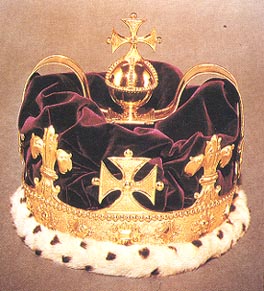

The British Crown Jewels
Written by Margaret Odrowaz-Sypniewski, B.F.A.

The British Imperial State Crown
During the fourteenth century, the King of Castile and Spain, defeated the Moorish king of Granada, Abu Said. Said had in his possession many jewels including four large "Balas rubies." Peter the Cruel, the Castillian king, stole Said's "rubies." Henry of Trastamara, Peter's half-brother, attacked the Castillian castle and Peter fled. At this time, Balas rubies were from Badachschan province in Syghinan Mountains in the Orient. Peter got Edward, the Black Prince (of England), to help him overthrow Henry in 1367. As payment for Edward's help, Peter gave him the largest of the Granada Balas rubies.
This ruby was used by Henry V and Richard III. In the 1600's, Oliver Cromwell took the royal crowns and had them destroyed. He then sold the jewels to whomever could pay the price he had set. As luck would have it, Charles II bought the Balas ruby in 1660. .
The famous ruby is now set into the British Imperial State Crown. It measures five centimeters long and weighs about 150 carats. Balas rubies (red spinel) are said to have the same properties as genuine rubies and protect owners against ill fortune.
Saint Edward's Sapphire
Edward the Confessor was known to wear a large sapphire ring. When Edward went to Westminster Abbey, he was approached by a beggar who pleaded for alms in the name of Saint John. Having no money, Edward removed his large sapphire ring, from his finger, and gave it to the man.
Years later, some travellers from Jerusalem returned the ring to Edward with a message that the beggar would soon meet him (Edward) in paradise. Edward died shortly after his ring's return.
Two hundred years after his death, Edward's coffin was opened and his ring was removed. It then was put on display in Westminster Abbey where it was highly venerated.
Edward's sapphire is now in the center of the pave-set diamond cross, mounted on the cross-strap of the British Imperial State Crown.
Diamonds
During the Middle Ages, diamonds were the knight's talisman, and they were often put upon their armor, shields, and sword hilts. In this time period diamonds came all the way from India, and were thought to have protective properties. Henry VIII had many rings with diamonds and other precious jewels. He was said to have a ring for every finger and his thumbs. He even had an effigy of El Cid, ancestor of both he and Catherine of Aragon. It depicted the Cid lying in Escorial Monastery. Henry VIII also embellished all his clothing with jewels.
In Elizabeth I's reign, courtiers wore "scribbling rings." These rings had a diamond octahedron (with one point longer than the rest). These rings were used to write "sweet nothings" upon the glass panes of their lady's (or lord's) bedroom windows. Sir Walter Raleigh was said to have scribbled upon his queen's window:
"Fain would I rise but that I fear to fall."
Elizabeth's reply was: "If thy heart fail thee, do not rise at all."
The Koh-i-Noor Diamond

In 1600, this diamond belonged to the Mughal Dynasty. It was believed that whomever owned this gem would rule the world. It was set into the Peacock Throne at the Palace of Delhi (in India), as the peacock's eye.
When Persia's Nadir Shah invaded India, in 1739, he tried to find the prized diamond, but it was no longer in the eye of the peacock. It seems that Mohammed Shah, the defeated Mongol ruler, had removed it and hidden it in his turban.

At a dinner, as was an ancient Asian custom, the Shah asked Mohammed to trade turbans. Of course, Mohammed Shah was destined to honor this request as per custom. When Nadir Shah removed the turban, before retiring to bed, the Koh-i-Noor (meaning "Mountain of Light") tumbled to the floor. It was thus named because of the large, fiery stars it made in the candlelight.
This stone then made its way to England in 1850. It was presented to Queen Victoria. However, by this time, the gem had a reputation of bringing misfortune to all its male owners. Queen Victoria knew of the diamond's history and made a strong request in her will warning that the crown should only be worn by the male ruler's queens. The Koh-i-Noor was set only in the crowns of the Queen Alexandria, Queen Mary and finally in the crown of Queen Elizabeth, the Queen Mother in 1936.
The Timur Ruby
The Timor Ruby was originally mined in India and was owned by the sultans of Delhi. Tamerlane invaded Delhi and constructed a pyramid of skulls, to display all he killed there. Tamerlane took the Timur Ruby and it was placed in the treasury of the Moghal Jenhangir and was given to Shan Jehan, the man who built the famous Taj Mahal palace. The ruby was stolen much like the Koh-i-Noor, Akbar Shah, and other Great Moghal diamonds by Nadir Shah, the Persian conqueror.
The Shah of Afghanistan saved the family of the assassinated Nadie Shah in 1747, and was rewarded with the Timor Ruby.
In 1849, the East Indian Company was paid reparations after wars in the Punjab. The East Indian Company then presented the ruby (used as payment) to Queen Victoria. The Timor Ruby is now part of a necklace worn by Elizabeth II on state occasions.
 ...
... 
MORE ABOUT CROWNS AND GEMS:
